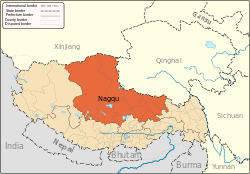Siling Lake
Siling Lake (Chinese: 色林错; pinyin: Sèlín Cuò; Tibetan: སེར་གླིང་མཚོ, ZYPY: Sêling Co ), (also known as Qilin) is a lake in the Tibet Autonomous Region, China to the north of Xainza. Doijiang is located near the lake. Administratively it belongs to Xainza County and Baingoin County of the Nagqu.
| Siling Lake / Siling Co | |
|---|---|
 | |
| Location | Nagqu Prefecture, Tibet, China |
| Coordinates | 31°50′N 89°00′E |
| Basin countries | China |
| Surface area | 1,865 km2 (720 sq mi) |
| Official name | Tibet Selincuo Wetlands |
| Designated | 8 January 2018 |
| Reference no. | 2352[1] |
The lake lies at an altitude of 4530 meters. It is a salt lake. It is fed by the rivers Za'gya Zangbo (or Tsagya Tsangpo) (扎加藏布) and the Boques Tsangpo (波曲藏布). With an area of 1865 square kilometers, Siling Co is the second largest saltwater lake in the northern Tibetan Plateau and forms part of the Siling Co National Nature Reserve (also Selincuo Reserve or Xainza Nature Reserve). The 400,000 hectare reserve was established in 1993 and contains significant populations of black-necked cranes and some 120 species of birds in total.[2][3] The lake only has a single species of fish, Gymnocypris selincuoensis, exploited by fishermen. The prairie on the banks of the lake is traditionally used as grazing land for yaks and sheep.
The temperature at the lake is an annual average of -3 to -0.6 °C, the maximum annual temperature 9.4 °C. The average rainfall is 290 millimeters per year, 90 percent of which falls in the months of June to September, often in the summer as hail.
Climate
| Climate data for Siling Lake | |||||||||||||
|---|---|---|---|---|---|---|---|---|---|---|---|---|---|
| Month | Jan | Feb | Mar | Apr | May | Jun | Jul | Aug | Sep | Oct | Nov | Dec | Year |
| Average high °C (°F) | −4.7 (23.5) |
−2.7 (27.1) |
1.2 (34.2) |
5.7 (42.3) |
10.1 (50.2) |
14.8 (58.6) |
15.7 (60.3) |
14.5 (58.1) |
12.4 (54.3) |
6.2 (43.2) |
0.0 (32.0) |
−3.2 (26.2) |
5.8 (42.5) |
| Daily mean °C (°F) | −11.9 (10.6) |
−9.8 (14.4) |
−5.9 (21.4) |
−1.3 (29.7) |
3.1 (37.6) |
7.9 (46.2) |
9.6 (49.3) |
8.7 (47.7) |
6.3 (43.3) |
−0.3 (31.5) |
−7.0 (19.4) |
−10.4 (13.3) |
−0.9 (30.4) |
| Average low °C (°F) | −19.0 (−2.2) |
−16.8 (1.8) |
−12.9 (8.8) |
−8.2 (17.2) |
−3.8 (25.2) |
1.1 (34.0) |
3.5 (38.3) |
3.0 (37.4) |
0.2 (32.4) |
−6.7 (19.9) |
−14.0 (6.8) |
−17.6 (0.3) |
−7.6 (18.3) |
| Average precipitation mm (inches) | 2 (0.1) |
2 (0.1) |
2 (0.1) |
5 (0.2) |
13 (0.5) |
39 (1.5) |
78 (3.1) |
74 (2.9) |
39 (1.5) |
7 (0.3) |
1 (0.0) |
1 (0.0) |
263 (10.3) |
| Source: Climate-Data.org | |||||||||||||
References
- "Tibet Selincuo Wetlands". Ramsar Sites Information Service. Retrieved 25 April 2018.
- Zheng, Du; Zhang, Qingsong; Wu, Shaohong (2000). Mountain geoecology and sustainable development of the Tibetan Plateau. Springer. p. 238. ISBN 978-0-7923-6688-1. Retrieved 31 March 2012.
- 安才旦 (1 January 2003). Tibet China: Travel Guide. 五洲传播出版社. p. 44. ISBN 978-7-5085-0374-5. Retrieved 31 March 2012.
